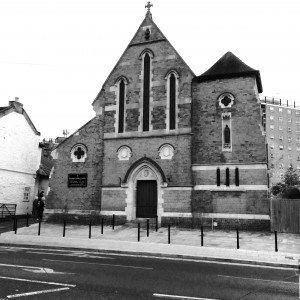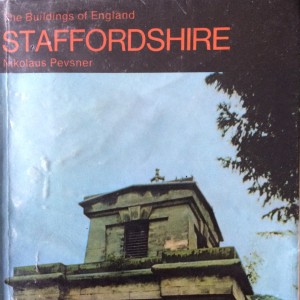
St Mary’s Church, High Street Brierley Hill is one of the buildings mentioned in Pevsner.
Designed by Walby Pugin the St Mary’s Church was opened on Wednesday 15th October 1873. The Birmingham Daily Post of 17th October contained the following article describing the events of the day. Even in those days there were worries about the condition of the building – foundations had cracked and the bell tower was (and is) yet to be be completed. During many toasts at a celebration in the public hall Brierley Hill dignitaries pledged the loyal support to Her Majesty “…if the socialistic, horrible, and infidel days which seemed imminent were to arrive”!
Opening of a Roman Catholic church at Brierley Hill Friday On Wednesday, a new Roman Catholic church was opened at Brierley Hill, with a great amount of ceremony.
The proceedings included the solemn opening by the Right Rev. Dr. Ullathorne, the rendering of a mass by a chosen choir, a sermon by the Bery Rev. Monsignor Capel, a public luncheon in the afternoon, and a special service at night.
The building itself fronts the High Street, or main thoroughfare, and consists of a nave, north aisle, chancel, sacristy, a small chapel, and tower. its dimensions inside are 80 ft by 30 ft, and with a height of 50 ft. and it will seat 400 persons. it is of red brick, with Bath stone dressings, and its styple is an example of Early English.
The pulpit is the gift of Mr Haskow, of Stourbridge, the font of Mr. W. W. Bright, and Mr Emery has acted as clerk of the works.
The proceedings commenced yesterday by service in the church, and a procession, including the Bishop, Monsignor Capel, and Conon O’Sullivan.
The church was well filled.
The choir rendered Mazzhingi’s Mass and selections from Weber, the solos being given by Miss Short (Birmingham), Mrs Hadly, Mrs. Bunce, Mrs. Beardmore, Mr Short, and Mr. Law.
Monsignor Capel then preached from the following words:
“I have chosen and have sanctified this place, that My name may be there for ever, and My eyes and My heart remain there perpetually;” after which the formal solemn opening of the church took place.
The celebrant was the Right Rev. Dr. Ullathroen, assistant priest the Rev. Canon O’Sullivan; deacons of the throng, Rev. Dr. Acton, Rev. S. Johnson; deacons of the mass, Revds. G. Duckett and Rev. John Ullathorne; masters of the ceremonies, Reev. S. Fenn and Rev. W,. Grancy.
The Vicar General (the Rev. Canon O’Sullivan) then proclaimed, in the name of the Bishop, a forty days’ indulgence to the members of the Roman Catholic faith present. A collection was are, and softly afterwards the congregation dispersed.
In the afternoon, a luncheon took place in the Public Hall, Brierley Hill: Sir Charles Clifford in the chair.
He was supported by the Rev. Canon O’Sullivan, Rev. P. Davies (Bloxwich), the Revds. Hall, Timothy, and Ryder (Wolverhampton), Revds. Bathurst and Fogarthy (Wednesdbury), Rev. T. Cukcett (Rugely), Rev. J. Bond (Dudley), the Revds. Barney (Willenhall), Power, Stoker, &c., Major Moseley, Mr Barclay, &c.
After the dinner the Chairman proposed “The Health of Pope Pius IX.” -(loud cheers)- and expressed his belief that before his Holiness died he would have obtained the victory over the enemies of his Pontificate and see his religion triumphant. (Hear, hear, and cheers.) – The Chairman then proposed “The Health of the Queen,” and said he was certain that her Majesty would have the loyal support of the Roman Catholics if the socialistic, horrible, and infidel days which seemed imminent, were to arrive. (Applause.)
The toast was drunk with cheers. – The Chairman next proposed “The Bishop and Clergy of the Diocese,” and spoke highly of the whole course of Bishop Ullathorne’s life, both abroad and at home. He also counselled Roman Catholics never to leave off trying to obtain their rights, by political as well as by other means, until they stood upon and equality with their fellow beings in the country. (Hear, hear.) –
Canon O’Sullivan, in a humorous speech responded on behalf of the bishop and clergy.
Mr R. Barclay proposed “Success to the New Church,” and praised the Rev. Mr. Revell for his sacrifices in the cause.
Mr Revell said that the work had been on hand twenty years, and £1,000 was ready to hand when he came among them. He hoped to live to see the completion of the work. (Applause.) – Mr Talbot responded.
Major Mosely proposed “The health of Monsignor Capel,” and this was drunk with great enthusiasm and cheering.
The Very Rev. Monsignor Capel thanked his audience for their kind but somewhat noisy welcome, which was particularly complimentary to a stranger. He had heard, among other things, that the foundations of the building were cracked a little, but he had faith in the roman Catholics of Brierley Hill, who had truth and pluck on their side, as well as unity, and with these they could not help succeeding. (Hear, hear). The building in which they had just worshipped was the work of a man of genius, and his art was shown in all his work. (Hear, hear). In concluding, he trusted that the younger members would do all to help to clear off the £000. debt on the building.
Mr Emery, having spoken as to the original movement for building the chapel, Mr Emery, jun. proposed “The health of Mr Walby Pugin, the architect, and Mr Horton, the builder.”
There were several other toasts, and the company, numbering nearly 200, then left.
In the evening the church was again crowded to hear an address from Monsignor Capel.
